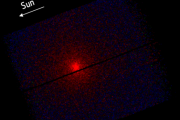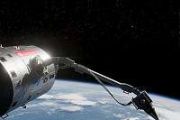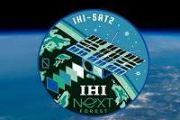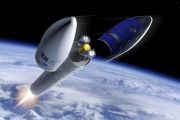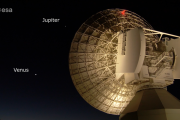
Copernical Team
AFRL spacecraft recurve launches on Virgin Orbit Space Force mission
 The Air Force Research Laboratory Space Vehicles Directorate spaceflight experiment Recurve was launched July 2, 2022, from the Mojave Air and Space Port on the Virgin Orbit space system in California. The launch supported the U.S. Space Force's STP-S28A mission and carried six additional payloads for the Department of Defense Space Test Program (STP).
Recurve is the latest in several low-
The Air Force Research Laboratory Space Vehicles Directorate spaceflight experiment Recurve was launched July 2, 2022, from the Mojave Air and Space Port on the Virgin Orbit space system in California. The launch supported the U.S. Space Force's STP-S28A mission and carried six additional payloads for the Department of Defense Space Test Program (STP).
Recurve is the latest in several low- Webb Telescope is now fully ready for science
 The months-long process of preparing NASA's James Webb Space Telescope for science is now complete. All of the seventeen ways or 'modes' to operate Webb's scientific instruments have now been checked out, which means that Webb has completed its commissioning activities and is ready to begin full scientific operations.
Each of Webb's four scientific instruments has multiple modes of operati
The months-long process of preparing NASA's James Webb Space Telescope for science is now complete. All of the seventeen ways or 'modes' to operate Webb's scientific instruments have now been checked out, which means that Webb has completed its commissioning activities and is ready to begin full scientific operations.
Each of Webb's four scientific instruments has multiple modes of operati NASA releases next wave of images from James Webb Space Telescope
 The James Webb Space Telescope began releasing a new wave of cosmic images on Tuesday, heralding a new era of astronomy.
"Every image is a new discovery," said NASA administrator Bill Nelson. "Each will give humanity a view of the universe that we've never seen before."
On Monday, Webb revealed the clearest image to date of the early universe, going back 13 billion years.
One new ima
The James Webb Space Telescope began releasing a new wave of cosmic images on Tuesday, heralding a new era of astronomy.
"Every image is a new discovery," said NASA administrator Bill Nelson. "Each will give humanity a view of the universe that we've never seen before."
On Monday, Webb revealed the clearest image to date of the early universe, going back 13 billion years.
One new ima James Webb Telescope to release more breathtaking cosmic views

After unveiling the clearest view yet of the distant cosmos, the James Webb Space Telescope has more to come.
The next wave of images on Tuesday will reveal details about the atmosphere of a faraway gas planet, a "stellar nursery" where stars form, a "quintet" of galaxies locked in a dance of close encounters, and the cloud of gas around a dying star.
They will be published starting from 10:30 am Eastern Time (1430 GMT), in an event live streamed from the NASA Goddard Space Flight Center, just outside Washington.
Targets include Carina Nebula, a stellar nursery, famous for its towering pillars that include "Mystic Mountain," a three-light-year-tall cosmic pinnacle captured in an iconic image by Hubble.
Webb has also carried out a spectroscopy—an analysis of light that reveals detailed information—on a gas giant planet called WASP-96 b, which was discovered in 2014.
Nearly 1,150 light-years from Earth, WASP-96 b is about half the mass of Jupiter and zips around its star in just 3.4 days.
Tech firms unveil plan for 'space-based' 5G network
 Thales, Qualcomm and Ericsson unveiled Monday a plan to allow smartphones to communicate directly with satellites, a "space-based network" they hope will bring connectivity to the entire globe.
The three firms envisage launching hundreds of satellites with 5G capabilities to bring coverage to "extreme geographies or remote areas across seas".
The plan would potentially cut out the base s
Thales, Qualcomm and Ericsson unveiled Monday a plan to allow smartphones to communicate directly with satellites, a "space-based network" they hope will bring connectivity to the entire globe.
The three firms envisage launching hundreds of satellites with 5G capabilities to bring coverage to "extreme geographies or remote areas across seas".
The plan would potentially cut out the base s Can FAST Detect Auroras on Brown Dwarfs
 Brown dwarfs are known as "failed stars", owing to the lack of central hydrogen burning. They bridge the gap between planets and stars. Some brown dwarfs are found to maintain kilogauss magnetic fields and produce flaring radio emissions, similar to aurora on magnetized planets in solar system, arousing astronomers' curiosities about their field properties and dynamos.
Radio emissions from
Brown dwarfs are known as "failed stars", owing to the lack of central hydrogen burning. They bridge the gap between planets and stars. Some brown dwarfs are found to maintain kilogauss magnetic fields and produce flaring radio emissions, similar to aurora on magnetized planets in solar system, arousing astronomers' curiosities about their field properties and dynamos.
Radio emissions from Black Hole Hunters - A citizen science search for black hole self-lensing
 A research team from the Open University and the University of Southampton is asking for the public's help to find some of the most mysterious, elusive objects in the Universe - black holes. By examining data from the SuperWASP survey, the UK's leading extra-solar planet detection programme, the team hope to detect changes in starlight that may provide evidence for the existence of these black h
A research team from the Open University and the University of Southampton is asking for the public's help to find some of the most mysterious, elusive objects in the Universe - black holes. By examining data from the SuperWASP survey, the UK's leading extra-solar planet detection programme, the team hope to detect changes in starlight that may provide evidence for the existence of these black h New Findings on the Formation of Ionized Carbon
 Scientists have long held that star formation creates ionized carbon giving vital information for understanding our universe. But a new study led by Universities Space Research Association's Robert Minchin, has shown that ionized carbon is also formed by galaxies moving through the hot gas of the Virgo cluster.
Since the 1990's scientists have suspected that ionized carbon might be formed
Scientists have long held that star formation creates ionized carbon giving vital information for understanding our universe. But a new study led by Universities Space Research Association's Robert Minchin, has shown that ionized carbon is also formed by galaxies moving through the hot gas of the Virgo cluster.
Since the 1990's scientists have suspected that ionized carbon might be formed Leaving Avanavero - Sol 3530
 The MAHLI images acquired on Sol 3528 confirm that the APXS was well placed over the Avanavero drill tailings, and the APXS data look good so we are ready to drive away from this location.
But first, we are planning a few more MAHLI and remote sensing observations. ChemCam will shoot its laser at a vein target named "Chiung" on the right side of the rover, then will acquire another RMI mos
The MAHLI images acquired on Sol 3528 confirm that the APXS was well placed over the Avanavero drill tailings, and the APXS data look good so we are ready to drive away from this location.
But first, we are planning a few more MAHLI and remote sensing observations. ChemCam will shoot its laser at a vein target named "Chiung" on the right side of the rover, then will acquire another RMI mos NASA's Perseverance Scouts Mars Sample Return Campaign Landing Sites
 The six-wheeled explorer has inspected a stretch of the Red Planet to see if it is flat enough for NASA's next Mars lander.
NASA's Perseverance Mars rover is conducting its science campaign, taking samples at Jezero Crater's ancient river delta, but it's also been busy scouting. The rover is looking for locations where the planned Mars Sample Return (MSR) Campaign can land spacecraft and c
The six-wheeled explorer has inspected a stretch of the Red Planet to see if it is flat enough for NASA's next Mars lander.
NASA's Perseverance Mars rover is conducting its science campaign, taking samples at Jezero Crater's ancient river delta, but it's also been busy scouting. The rover is looking for locations where the planned Mars Sample Return (MSR) Campaign can land spacecraft and c 




